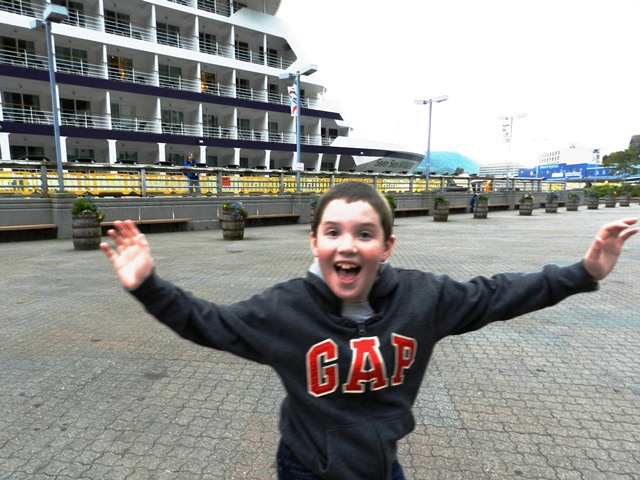» posted on Friday, July 27th, 2012 by Linda Lou Burton
Highs and Lows
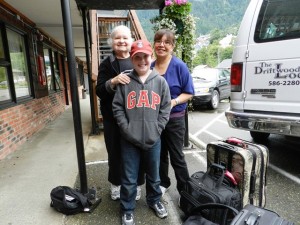 Linda Burton posting from Juneau, Alaska – “Come over here Sam,” June said. “Stand by your Grandma and me. I want our picture together.” We posed, smiling; Mark came out of the office to snap us with June’s camera and with mine. “Are you sure you can drive this van?” Sam asked as June pulled her seat way, way forward. “You’re not much taller than me.” June and I burst out laughing and assured Sam that height didn’t affect driving ability. Then we proceeded to swap stories about our early driving days and near accidents we’d had. “I’m not going to listen,” said Sam from the back seat, covering his ears. It was 14 miles to the airport from downtown’s Driftwood Lodge along the Gastineau Channel; the tide was in at the moment; we’d seen it at low tide when it was mostly mud. Highs and lows. Hugs at the front door of the airport; the kind you have when you know you will truly miss a person. “Goodbye June in Juneau,” Sam said, and we wheeled our luggage in; easy maneuvers in this small airport. The
Linda Burton posting from Juneau, Alaska – “Come over here Sam,” June said. “Stand by your Grandma and me. I want our picture together.” We posed, smiling; Mark came out of the office to snap us with June’s camera and with mine. “Are you sure you can drive this van?” Sam asked as June pulled her seat way, way forward. “You’re not much taller than me.” June and I burst out laughing and assured Sam that height didn’t affect driving ability. Then we proceeded to swap stories about our early driving days and near accidents we’d had. “I’m not going to listen,” said Sam from the back seat, covering his ears. It was 14 miles to the airport from downtown’s Driftwood Lodge along the Gastineau Channel; the tide was in at the moment; we’d seen it at low tide when it was mostly mud. Highs and lows. Hugs at the front door of the airport; the kind you have when you know you will truly miss a person. “Goodbye June in Juneau,” Sam said, and we wheeled our luggage in; easy maneuvers in this small airport. The  nice ladies in Security chatted with Sam about his visit and gave him a TSA sticker for his shirt; he eyed me grinning “I didn’t have to take off my shoes!” Grandson Sam and I are leaving Juneau now, feeling high and low. High to get back to regular life – Sam to his Dad and Mom and a new neighborhood; me to my kitties and the rest of the Journey. Low because we’ve adopted Juneau in our hearts. So many nice people!
nice ladies in Security chatted with Sam about his visit and gave him a TSA sticker for his shirt; he eyed me grinning “I didn’t have to take off my shoes!” Grandson Sam and I are leaving Juneau now, feeling high and low. High to get back to regular life – Sam to his Dad and Mom and a new neighborhood; me to my kitties and the rest of the Journey. Low because we’ve adopted Juneau in our hearts. So many nice people!
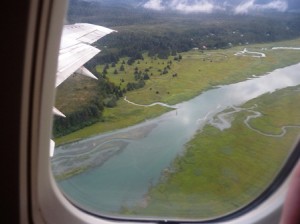 Sam claimed the window seat; we gave a thumbs up as the plane lifted from the ground; Sam pulled me over to see the Gastineau Channel below us. “It looks just like the map in the museum,” he said. We’d looked at a relief map of the area in the Juneau City Museum the day before, the Docent laser-
Sam claimed the window seat; we gave a thumbs up as the plane lifted from the ground; Sam pulled me over to see the Gastineau Channel below us. “It looks just like the map in the museum,” he said. We’d looked at a relief map of the area in the Juneau City Museum the day before, the Docent laser-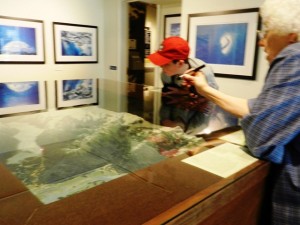 pointed to the Mendenhall Glacier and River and the Channel, which separates the mainland, and Juneau, from Douglas Island. Below us now we could clearly see the effects of the silt from the glacier melt; the space is narrow and impassable now for the large ships; they can only come as far as the Juneau-Douglas Bridge. Between the bridge and the airport only small boats can get through, and then only at high tide. “It will close completely someday,” the Docent had said, “unless it is dredged out.”
pointed to the Mendenhall Glacier and River and the Channel, which separates the mainland, and Juneau, from Douglas Island. Below us now we could clearly see the effects of the silt from the glacier melt; the space is narrow and impassable now for the large ships; they can only come as far as the Juneau-Douglas Bridge. Between the bridge and the airport only small boats can get through, and then only at high tide. “It will close completely someday,” the Docent had said, “unless it is dredged out.”
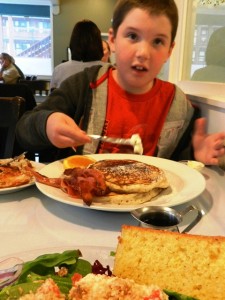 We’d had a busy day today; a final meal at the Sandpiper next door, where we had our first meal on our first day in Juneau; it seemed a
We’d had a busy day today; a final meal at the Sandpiper next door, where we had our first meal on our first day in Juneau; it seemed a  fitting way to end our stay. Sam’s pancakes and bacon and hashbrowns came in Alaska-sized portions; so did my salad-with-cornbread; we couldn’t eat it all; maybe we were just excited. We’d stored our luggage in the Office of the Lodge and returned our rental car, where Sam had one last bonding with Elena, the gentle giant of a dog that did tricks for him when we first met her.
fitting way to end our stay. Sam’s pancakes and bacon and hashbrowns came in Alaska-sized portions; so did my salad-with-cornbread; we couldn’t eat it all; maybe we were just excited. We’d stored our luggage in the Office of the Lodge and returned our rental car, where Sam had one last bonding with Elena, the gentle giant of a dog that did tricks for him when we first met her.
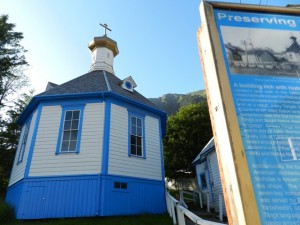 We’d rushed around yesterday afternoon too, trying to see everything, like the Russian Orthodox Church perched high on the hill overlooking town. So pretty in blue and white with its gold cross atop, the church has been there since 1894. We were surprised to learn it wasn’t built for Russians, but for the Native Tlingit, who were allowed to use their own language in Russian Orthodoxy services. (American missionaries were under instruction to suppress native languages.) Architectural drawings were sent from Russia, as well as articles for the interior such as candle stands, banners, and a full icon-screen; many of those items are still in use today. Local timber and local labor were used; the “onion” dome was constructed in 1895
We’d rushed around yesterday afternoon too, trying to see everything, like the Russian Orthodox Church perched high on the hill overlooking town. So pretty in blue and white with its gold cross atop, the church has been there since 1894. We were surprised to learn it wasn’t built for Russians, but for the Native Tlingit, who were allowed to use their own language in Russian Orthodoxy services. (American missionaries were under instruction to suppress native languages.) Architectural drawings were sent from Russia, as well as articles for the interior such as candle stands, banners, and a full icon-screen; many of those items are still in use today. Local timber and local labor were used; the “onion” dome was constructed in 1895 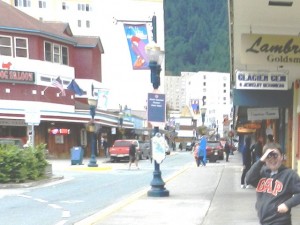 and the bell and belfry in 1906; the bell was cast in St Petersburg, Russia. Down at the bottom of the hill by the waterfront, we walked past the Red Dog Saloon; it too is a historical fixture in Juneau, going back to the glorious mining days when Ragtime Hattie played the piano in white gloves and a silver-dollar halter top. During territorial days owner Gordie Kanouse met the tour boats on his mule, with a sign that read “Follow my ass to the Red Dog Saloon.” Today it takes up a corner at the edge of the downtown historic district, where gold and jewelry shops continue to “mine” the pockets of the cruise-ship crowds.
and the bell and belfry in 1906; the bell was cast in St Petersburg, Russia. Down at the bottom of the hill by the waterfront, we walked past the Red Dog Saloon; it too is a historical fixture in Juneau, going back to the glorious mining days when Ragtime Hattie played the piano in white gloves and a silver-dollar halter top. During territorial days owner Gordie Kanouse met the tour boats on his mule, with a sign that read “Follow my ass to the Red Dog Saloon.” Today it takes up a corner at the edge of the downtown historic district, where gold and jewelry shops continue to “mine” the pockets of the cruise-ship crowds.
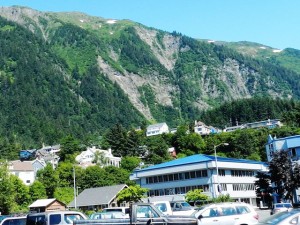 “We learned geology and history and politics and physical fitness, didn’t we?” I asked Sam, as we glided over cloud cover now and thought about what we’d done in Juneau. “Think about those steps!” Many Juneau residents think nothing of a 60-step climb to get to their house; that’s what June climbs every evening after she leaves the hotel (and sometimes she has to wait for the bears to leave!). Every day from the parking lot of our hotel we’d seen the Governor’s Mansion perched high atop a hill; yesterday afternoon we finally drove the winding route uphill to find it; the street that ran in front also continued around to the capitol, a “balconied” walk along a banner-lined sidewalk; to the right 108 steps led down to the level of our hotel; to the left more steps
“We learned geology and history and politics and physical fitness, didn’t we?” I asked Sam, as we glided over cloud cover now and thought about what we’d done in Juneau. “Think about those steps!” Many Juneau residents think nothing of a 60-step climb to get to their house; that’s what June climbs every evening after she leaves the hotel (and sometimes she has to wait for the bears to leave!). Every day from the parking lot of our hotel we’d seen the Governor’s Mansion perched high atop a hill; yesterday afternoon we finally drove the winding route uphill to find it; the street that ran in front also continued around to the capitol, a “balconied” walk along a banner-lined sidewalk; to the right 108 steps led down to the level of our hotel; to the left more steps 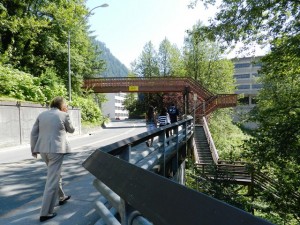 continued uphill; pedestrians passed us each way. We walked to the Mansion’s door and I dialed as instructed; if it was convenient they’d invite you in for a tour. “Not today,” the voice said in apology. The Mansion celebrated 100 years the week before; they had Open House and a picnic on the lawn; the town was invited. Unfortunately, I read about it in the paper the day after the event. Walter Clark was the first Territorial Governor to occupy the house, back in 1912.
continued uphill; pedestrians passed us each way. We walked to the Mansion’s door and I dialed as instructed; if it was convenient they’d invite you in for a tour. “Not today,” the voice said in apology. The Mansion celebrated 100 years the week before; they had Open House and a picnic on the lawn; the town was invited. Unfortunately, I read about it in the paper the day after the event. Walter Clark was the first Territorial Governor to occupy the house, back in 1912.
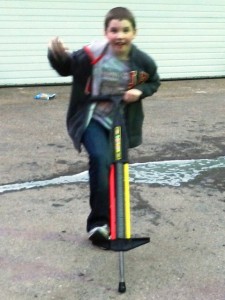 “We missed the Coast Guard,” I said to Sam. “We never got to their offices for a visit.” The Coast Guard is a big presence in Juneau, responsible for overseeing the Channel waters. “And we never saw a bear, even though they walked around our hotel every night.” “But we saw whales and sled dogs and eagles,” Sam piped in. “And I learned to ride a pogo stick. Almost.” It’s dark now; we’re almost to Seattle; about to go from 30,000 feet back down to earth. “One last thing,” I say to Sam, “What was your favorite thing you did in Juneau?” “Making videos,” Sam answered, falling into his radio voice. “This is Samuel Isaac Burton Shumate, reporting live.”
“We missed the Coast Guard,” I said to Sam. “We never got to their offices for a visit.” The Coast Guard is a big presence in Juneau, responsible for overseeing the Channel waters. “And we never saw a bear, even though they walked around our hotel every night.” “But we saw whales and sled dogs and eagles,” Sam piped in. “And I learned to ride a pogo stick. Almost.” It’s dark now; we’re almost to Seattle; about to go from 30,000 feet back down to earth. “One last thing,” I say to Sam, “What was your favorite thing you did in Juneau?” “Making videos,” Sam answered, falling into his radio voice. “This is Samuel Isaac Burton Shumate, reporting live.”

